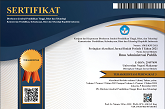Analysis Of The Existence Of Indigenous Peoples In The Implementation Of Nagari Government In Solok Regency (Case Study: Nagari Cupak, Gunung Talang District)
(1) Department of Public Administration, Universitas Negeri Padang, Indonesia
(2) Department of Public Administration, Universitas Negeri Padang, Indonesia
(*) Corresponding Author
DOI: https://doi.org/10.26858/jiap.v12i2.31418
Abstract
This study aims to determine the analysis of the existence of indigenous peoples in the administration of nagari government in Solok Regency and to describe what are the strengths in the analysis of the existence of indigenous peoples in the administration of nagari government in Solok Regency. This research is qualitative in nature using descriptive methods, so this writer will describe what was done in analyzing the existence of indigenous peoples in the administration of nagari government in Solok Regency, the obstacles encountered in realizing the existence of indigenous peoples and efforts to solve them. The results of this study are the State's effort to apply the same principle in village governance arrangements with different forms of government, which is an effort to keep diversity in unity. However, equating the principle of regulation in a communal society such as Nagari with the Village, in the end resulted in problems in the Nagari Government. The combination of adat and public administration in the context of a hybrid system has made Nagari the same as Desa. The enactment of Law number 6 of 2014 concerning Villages which was responded to by Regional Regulation Number 7 of 2018 has strengthened the position of the Nagari Government as a traditional village with another name. Unfortunately, there is still no customary government that is autonomous according to its special rights of origin. The regulation of Traditional Villages with other names is recognized by the state as long as they do not conflict with the principles of Village regulations regulated by law. The Nagari Government Regulation in Regional Regulation Number 7 of 2018 concerning Nagari which strengthens Nagari as a Traditional Village with another name is still a hybrid system. The existence of Nagari which was revived by the government is something that makes the Nagari people have too high expectations that their management will be able to be managed as Nagari used to be thick with traditional values. If the government does not fully provide genuine autonomy, the advice that researchers can give is the separation between traditional villages and administrative villages.
Keywords
Full Text:
PDFReferences
Baoying, G. (2015). The Legal Basis of Delegation of Governmental Powers in a Changing Society. Social Sciences in China, 36(3), 106–123. https://doi.org/10.1080/02529203.2015.1062231
Cahaya, A., Akib, H., Said, F., Mustari, & Yahyaddin, M. (2019). Snapshot of the socio-economic life of fishermen community based on social entrepreneurship in Bone Regency, Indonesia. Academy of Entrepreneurship Journal, 25(1).
Dolfsma, W., & Seo, D. (2013). Government policy and technological innovation—a suggested typology. Technovation, 33(6–7), 173–179.
Eltrudis, D., & Monfardini, P. (2020). Are Central Government Rules Okay? Assessing the Hidden Costs of Centralised Discipline for Municipal Borrowing. Sustainability, 12(23), 9932.
Frinaldi, A. (2021). Work Culture, Digital Governance and Employees Happiness in Pariaman City. TIC 2020: Proceedings of the 1st Tidar International Conference on Advancing Local Wisdom Towards Global Megatrends, TIC 2020, 21-22 October 2020, Magelang, Jawa Tengah, Indonesia, 1.
Ismail, A., Sulur, A. H., Akib, H., & Salam, R. (2016). Snapshot of Society Social-Economic Welfare based on Human Development Index in Polewali Mandar Regency, Indonesia. International Conference on Public Organization VI (ICONPO VI), 847–858.
Marcus, C. C., & Francis, C. (1997). People places: design guidlines for urban open space. John Wiley & Sons.
Musliamin, M., Nawawi, D., Rakhmat, R., & Abdullah, M. T. (2020). The Performance of the Regional People’s Representative Council in Implementing the Legislative and Budgeting Functions in Bone Regency. International Journal of Multicultural and Multireligious Understanding, 7(9), 93–103.
Omri, W. (2015). Innovative behavior and venture performance of SMEs: The moderating effect of environmental dynamism. European Journal of Innovation Management, 18(2), 195–217. https://doi.org/10.1108/EJIM-02-2013-0015
Osborne, D., & Gaebler, T. (1992). Reinventing government: How the entrepreneurial spirit is transforming government. In Reading Mass. Adison Wesley Public Comp.
Pfeffer, J. (1994). Competitive advantage through people. Boston/Mass.
Prawoto, N., Purnomo, E. P., & Zahra, A. A. (2020). The Impacts of Covid-19 Pandemic on Socio-Economic Mobility in Indonesia. VIII(3), 57–71.
Raines, J. P., & Leathers, C. G. (2000). Behavioral influences of bureaucratic organizations and the Schumpeterian controversy. The Journal of Socio-Economics, 29(4), 375–388. https://doi.org/https://doi.org/10.1016/S1053-5357(00)00081-0
Robbins, S. P., & Judge, T. A. (2013). Organizational behavior (Vol. 4). New Jersey: Pearson Education.
Turan, M., & Kara, A. (2018). Online social media usage behavior of entrepreneurs in an emerging market: Reasons, expected benefits and intentions. Journal of Research in Marketing and Entrepreneurship, 20(2), 273–291. https://doi.org/10.1108/JRME-09-2016-0034
Vaterlaws-Whiteside, H., & Hartmann, A. (2017). Improving puppy behavior using a new standardized socialization program. Applied Animal Behaviour Science, 197, 55–61.
Article Metrics
Abstract view : 193 times | PDF view : 56 timesRefbacks
- There are currently no refbacks.
Copyright (c) 2022 Ferrya Hamid Loedy, Aldri Frinaldi

This work is licensed under a Creative Commons Attribution 4.0 International License.
Diterbitkan oleh:
Program Studi Ilmu Administrasi Publik
Program Pascasarjana Universitas Negeri Makassar
JIAP Index By:

This work is licensed under a Creative Commons Attribution 4.0 International License.









